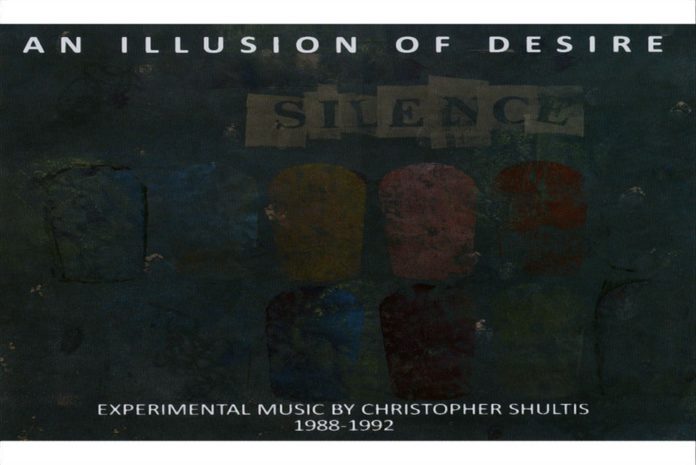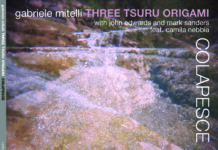After the late 1990s, Shultis seems to have undergone a turn away from a primary concern with experimentalism and toward more conventional, fully notated compositions. Much of the later work was inspired by his encounters with the natural environment of New Mexico; some of it is collected on the aptly titled CD Devisadero: Music from the New Mexico Wilderness [Navona NV 5849] which appeared in 2011. The recording includes works for orchestra and for piano, as well as songs for soprano. The earliest work, “a little light, in great darkness”for soprano saxophone and woodwind quartet, is dated 1995-2000 and may capture a transitional moment bridging Shultis’s experimental and post-experimental periods. This fourteen-minute-long piece shows a move toward a more conventionally modernist harmonic vocabulary, but retains the open texture of the earlier work, often having individual instruments play single tones bracketed by silences. In its co-situating of experimental and conventional musical properties, “a little light, a great darkness” embodies what Shultis in the 2000 interview called his preference for “the Janus-face-like nature of the world”–a world where seemingly opposed phenomena reveal their mutual dependence.
Christopher Shultis & the Experimental Music Tradition
The 1920s and 1930s were a fertile time for experimental music in America. Composers such as Henry Cowell, George Antheil, William Russell—and very soon after, John Cage—explored an expanded palette of sounds as well as methods of musical organization. Percussion ensembles played an important if not always fully acknowledged role in the development of what Cowell and others have termed the American Experimental Tradition; Christopher Shultis, a percussionist who later turned to composition and the study of modern American music in historical context, was not only aware of the importance of percussion for the experimental tradition, but through his music and musicology has situated himself within that tradition.
Shultis (b. 1957) came to composition relatively late, after having established himself as a gifted percussionist conversant with a wide repertoire. A professor emeritus of the University of New Mexico, Shultis became director of the percussion program there at age 22, and led the University of New Mexico Percussion Ensemble. Beyond performance, he contributed to furthering new music through his establishment of a composers’ symposium which took place annually for thirty years. A neck injury which manifested itself in hand pain forced an end to his career as a performer; he stopped performing altogether in 1994 and redirected his energy not only toward composition, but toward American Studies and musicology, in which field he published a book on John Cage—whom he met at the 1988 Composers Symposium–and the roots of American experimental music.
Realizations of five of Shultis’s early compositions, dating between 1988 and 1992, appear on the CD An Illusion of Desire [Neuma 450-115]. Two of the five are centered on percussion, while the other three are scored for voice and electronics, theremin, and voice, crotales and piano. All are from what Shultis refers to as his “experimental period” and consequently are informed by his deeply cultivated sense of the sound worlds, gestures and philosophy of American experimentalism.
Oneiro (1988/1992), a work for percussion trio, and 4-7-3(1989/2015), for percussion duet and electronics, continue the tradition of the percussion ensemble as a medium for experimental work concerned with the enrichment of musical timbre. Shultis wrote the two works to be played by himself; the deliberately non-virtuosic demands they place on the performer reflect the physical limitations his injury imposed on his own ability to play. Both pieces are long, slowly unfolding settings for deliberately-spaced events—as much clearings in which sounds can be as they are self-conscious works of art. Oneiro explores the rich variety of sounds made by struck metals and glass, while 4-7-3, which Shultis rewrote in 2015, incorporates into a new performance of piano, crotales, percussion and vibraphone a recording of Shultis on tam-tam that had been made for the work when it was originally written.
With their sparse and open textures, both of these works are susceptible to what Shultis in a 2000 interview in Peer Magazine termed “the inclusion of the unintentional outside.” They are consistent with that kind of experimental work that stands at a point of erasure, where the delineation of inside and outside is at least potentially effaced. This is achieved through a permeability of texture wherein the work is organized in such a way that outside sounds are let in, and its relationship to its surroundings becomes part of its internal meaning. Cage’s 4’33” is an extreme example of the permeable work, but whether through Cage’s piece or through the incorporation of non-musical sounds into earlier and subsequent experimental works, permeability has become an established feature of the experimental tradition.
Other works on the recording draw on unusual timbres, as does Gesturing Hands for theremin, or explicitly foreground the process of their making. An example of the latter, Metaphysics, for voice and eight tape recorders, builds ever-thickening layers of sound from an ongoing system of accumulation. Starting with Shultis’s speaking voice, it records, replays and records iteratively until the voice seems to become lost in a forest of its own echoes.







